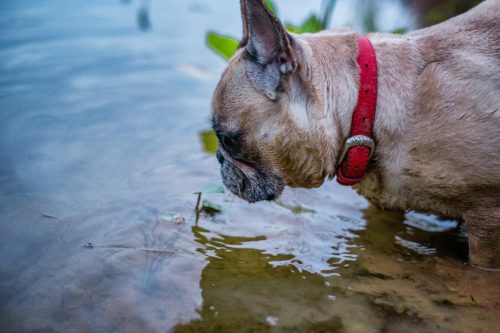Just like humans, when a dog vomits, their body is trying to signal that something is wrong. Whether it’s a minor or severe cause, vomiting in dogs is a common act that occurs when their stomach is upset and they need to expel a substance from their digestive system that is either causing irritation or is a toxin to the body.
If your dog is vomiting yellow, foam, or any other abnormal characteristic for that matter, be sure to deliver this information to your veterinarian as well. Although it may be graphic, these signs can be flags of specific issues that are going on inside your pup. This information will help to narrow down the search when trying to find the main issue. The more information you can provide to your vet, the faster you can get your dog on the road to recovery.
Common reasons that dogs vomit include eating indigestible substances that upset their stomach or even overindulging right before a tough workout. Although random vomiting should not raise major concern, it is important to note when this issue begins to occur on a frequent basis or is combined with other symptoms.
When you go to your vet, be prepared to provide them with all your dog’s previous symptoms and a full report of their overall health. Unless your dog is vomiting right after consuming a specific type of food or after they have eaten a large helping of grass, it can be hard to identify the main cause of their underlying issue. If your dog is sick, take note of what they consumed prior, what the vomit looks like, and any other changes in behavior that may help your vet with their diagnosis.
As a dog owner, it is your job to make sure your pet is as healthy as possible. Once you notice a change in their health, especially if they are vomiting or having diarrhea excessively, take them in for an extensive examination. Although this may seem excessive, most dogs never show a single symptom when they are suffering from a disease or serious illness until the damage has already been done.
If they are suffering from a more severe condition, the faster you are able to seek treatment, the better the chance they will be able to make a full recovery. Remember that dogs are unable to tell you when something doesn’t feel right. Maybe they have an upset stomach that will go away on its own, but unfortunately there are other severe conditions that may cause vomiting as well. The only way your dog can communicate that they are feeling sick is through the symptoms they portray and how their body is reacting.
This article will cover why your dog is vomiting yellow foam and what you should do as their owner to treat them. Don’t panic at the first health complication that inflicts your dog. Just like in humans, most health problems can be cured with a change in diet or some antibiotics prescribed by a professional. As long as you are an informed owner, you will be able to provide your pet with the best treatment possible and have them back to a healthy and happy life in no time at all.
Why is My Dog Vomiting?

There are many reasons why dogs vomit, and one of the main factors is because they have an upset stomach. Some factors that cause a dog to vomit include:
- Consuming garbage or spoiled food
- Consuming toxic chemicals or substances
- Exercising right after a big meal
- Eating too fast
- Bloat
- Inflammatory bowel disease
- Consuming a large amount of grass
- Motion sickness
Any time a dog overeats, consumes something that upsets their stomach, or are experiencing some type of reaction, they may fall victim to vomiting and other symptoms. The causes listed above are generalized, but they are still relevant when discussing causes of stomach issues in dogs. As said before, vomiting can be caused by a variety of sources, but if your dog is continuously vomiting in the same way, then that may be a sign of a more specific issue.
If your dog is vomiting yellow mucus or a yellow substance, this is usually a sign that they have an empty stomach and are throwing up bile. Although it may be a shocking sign, it is actually quite common and occurs in many older dogs. This condition is also known as bilious vomiting syndrome.
Bilious Vomiting Syndrome
Bilious vomiting syndrome occurs when the bile from the small intestine irritates the stomach and causes the dog to vomit. Bile is a yellow fluid that is processed in the liver and used in the small intestine during the digestion process of the body. The bile is then used to break down the food and help transport nutrients to different areas. Sometimes, instead of the bile passing with the food and being reabsorbed, it travels in the wrong direction, ending up in the stomach.
Once it is in the stomach, it can cause irritation or inflammation in dogs due to its acidic properties. Many dogs will experience bilious vomiting syndrome on an empty stomach when the bile is in direct contact with the stomach lining.
If your dog is vomiting yellow foam and it is because they have an empty stomach, try giving them their meals closer together. This doesn’t mean you need to feed them a larger amount, but instead try portioning out their daily allotment into smaller portions. If your dog is relatively healthy and they are still throwing up bile, this could be because they have consumed too much fatty foods, drank too much water in a short period of time, or have eaten a large amount of grass.
If a dog has bilious vomiting syndrome but they are not vomiting, they could develop gastric reflux. This condition occurs when there is a reverse flow of intestinal fluids that go into the tube connecting the stomach and throat. Acid reflux can cause damage to the esophagus, pain while swallowing, weight loss, or a lack of appetite in dogs. In many cases, you will be able to tell if your dog has gastric reflux just by the way they interact with their food.
Severe Issues Linked to Yellow Vomiting
While the majority of time yellow vomiting is linked to bilious vomiting syndrome which is relatively harmless, a dog who is throwing up yellow foam can also have a much more serious condition.
If your dog’s yellow vomit is accompanied by diarrhea, weight loss, or lethargy, this could mean that a more severe problem is threatening their overall health. Possible health concerns that can cause your dog to vomit yellow foam can include:
- Pancreatitis
- Liver disease
- Ulcers
- Parasites
- Allergies
- Toxins
What to Do if Your Dog is Vomiting Yellow Foam

As mentioned before, vomiting is a common occurrence for dogs and a single incident should not spark a major urgency to seek immediate help. What you should note however is how your dog acts after he vomits, what the vomit looks like, and any other symptoms that may be apparent. If the vomiting is frequently occurring, it may be time to take your dog to a veterinarian for further examination.
Once you are at the vet, provide them with as much information on your dog’s condition as possible. From there, the vet will run a series of physical examinations and diagnostic tests to uncover the main cause of their health condition. Possible tests that may be used include a urinalysis, a chemical blood profile, a complete blood profile, and any other test your vet feels is necessary.
Even after these tests have been run, it doesn’t necessarily mean your vet will come up with an immediate diagnosis. Since dogs who have bilious vomiting syndrome are generally healthy, all of their blood work and other testing will be relatively normal.
Keep in mind that if your dog is older, stomach issues are a common occurrence. This is especially true in the morning before your dog has been fed or late at night if it has been awhile since their last meal.
If your dog has vomited several times, try to understand the main source of the issue. When a dog vomits normally, most professionals recommend reducing the amount you are feeding them since this is usually due to an upset stomach. However, if your dog is suffering from bilious vomiting syndrome where they are throwing up yellow foam, this should not be your first plan of action.
Treatment For A Dog Who Is Vomiting Yellow Foam
After your vet rules out any major health concerns, they will prescribe a gastric motility medication which will help increase the activity in the stomach. Depending on their severity of their condition, a dog should experience an improvement in their overall health within just a few weeks.
But it is also important to remember that each animal is unique and may respond differently to the drugs. That’s why you should keep in contact with your veterinarian and let them know if your dog experiences any more changes in their overall health or behavior.
Aside from a prescription medication, your veterinarian will suggest feeding your dog multiple meals throughout the day. Make sure you are not overfeeding your dog when you increase the frequency of their mealtime. Just because they are receiving more food does not mean they need to be given larger amounts. The goal here is to have food in their stomach throughout the day, not to have them develop obesity or diabetes from overconsumption.
When it comes to their actual food, try looking for products that are low in fat and fiber. These foods will also help their stomach motility and will help with their bilious vomiting syndrome. What you feed your dog can have a major impact on their overall health.
That’s why it’s important to carefully follow your vet’s instructions and feed your pet only the food they recommend, especially if they have a weak or irritated stomach. Use your vet as your go-to source for any information that is specific to your dog’s personal health.
Caring For Your Dog

Although it may be alarming to see your dog vomiting yellow foam, stay calm. Even though this does not seem normal, it is not indicative that something is seriously wrong. Most dogs who vomit yellow foam have a condition called bilious vomiting syndrome that causes bile to irritate their stomach lining which can lead to inflammation.
If you notice your dog do this once or twice over a long period of time, it’s okay. If this is happening every other day, it is wise to take them into the veterinarian for a physical analysis. This condition is especially common for dogs who are older or if they are only fed one large meal a day.
In most cases, if you split up their daily food ration into smaller portions, they should be back to normal in no time at all. Remember this is caused by a lack of food in their stomach, so the best way you can prevent this from happening is by feeding them smaller portions throughout the day.
If your dog’s symptoms only worsen or are accompanied by other more serious signs such as weight loss or lethargy, make sure they seek professional help right away. As a dog owner, it is critical that you analyze your dog’s overall health and make sure they are as healthy as possible. Pay attention to their behavior, symptoms, or sudden changes that may be pointing to a more serious issue at hand.
To keep your dog in tip-top shape, feed them a balanced diet, give them plenty of exercise, and take them to the vet for their annual check-ups. These key factors set the foundation for being the best guardian you can be for your furry companion.
Sources:
- Fuller, Mary. “Why Is My Dog Throwing Up Yellow Foam?” Vetstreet, 24 May 2012, Accessed 10 Dec. 2017. www.vetstreet.com/our-pet-experts/why-does-my-dog-vomit-yellow-foam.
- Gilpatrick, John. “5 Reasons Why Your Dog Is Throwing Up Bile.” PetMD, Accessed 10 Dec. 2017. www.petmd.com/dog/general-health/5-reasons-why-your-dog-throwing-bile.
- Elliott, Pippa. “What to Do When Your Dog Vomits Yellow Bile.” Petful, 23 Mar. 2017, Accessed 10 Dec. 2017. www.petful.com/pet-health/dog-vomit-yellow-bile/.
- “Vomiting Yellow Foam in Dogs – Definition, Cause, Solution, Prevention, Cost.” WagWalking, 8 July 2017, Accessed 10 Dec. 2017. www.wagwalking.com/symptom/why-is-my-dog-vomiting-yellow-foam.
- “Dog Throws Up Yellow Foam.” VetInfo, Accessed 10 Dec. 2017. www.vetinfo.com/dog-throws-up-yellow-foam.html.




